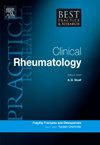系统性红斑狼疮的分类:从制定分类标准到新的分类法?
IF 4.5
2区 医学
Q1 RHEUMATOLOGY
Best Practice & Research in Clinical Rheumatology
Pub Date : 2023-12-01
DOI:10.1016/j.berh.2024.101949
引用次数: 0
摘要
系统性红斑狼疮是一种变化多端的系统性自身免疫疾病。人们对其免疫病理效应阶段有部分了解。然而,其变异的背景却并不清楚。系统性红斑狼疮的分类标准一直依赖于临床表现和标准自身免疫血清学。2019 年 EULAR/ACR 分类标准依然如此。一方面,这大大提高了系统性红斑狼疮患者定义的精确度。另一方面,标准中的信息既无助于了解患者的病理生理学,也无法预测现有免疫调节疗法的疗效。进一步改进临床标准的机会很可能是有限的。这正是新的多组学方法开始发挥作用的地方。虽然还不能像分类标准那样精确地区分疾病,但这些研究结果在免疫失调方面远远超出了标准的范围。我们在此对这两方面进行了详细分析,并尝试对现有数据进行综合,以期更好地了解系统性红斑狼疮及其免疫病理生理学。本文章由计算机程序翻译,如有差异,请以英文原文为准。
Classification of systemic lupus erythematosus: From the development of classification criteria to a new taxonomy?
SLE is a highly variable systemic autoimmune disease. Its immunopathological effector phase is partly understood. However, the background of its variability is not. SLE classification criteria have been relying on the clinical manifestations and standard autoimmune serology. This still holds true for the 2019 EULAR/ACR classification criteria. On one hand, this has led to significant precision in defining patients with SLE. On the other hand, the information in the criteria neither helps understanding the individual patient's pathophysiology, nor does it predict the efficacy of the available immunomodulatory therapies. Chances of further improvement of clinical criteria are most likely limited. This is where new multi-omic approaches have started to make an impact. While not yet able to differentiate diseases with the same precision as the classification criteria, the results of these studies go far beyond the scope of the criteria with regard to immune dysregulation. Looking at both sides in detail, we here try to synthesize the available data, aiming at a better understanding of SLE and its immune pathophysiology.
求助全文
通过发布文献求助,成功后即可免费获取论文全文。
去求助
来源期刊
CiteScore
9.40
自引率
0.00%
发文量
43
审稿时长
27 days
期刊介绍:
Evidence-based updates of best clinical practice across the spectrum of musculoskeletal conditions.
Best Practice & Research: Clinical Rheumatology keeps the clinician or trainee informed of the latest developments and current recommended practice in the rapidly advancing fields of musculoskeletal conditions and science.
The series provides a continuous update of current clinical practice. It is a topical serial publication that covers the spectrum of musculoskeletal conditions in a 4-year cycle. Each topic-based issue contains around 200 pages of practical, evidence-based review articles, which integrate the results from the latest original research with current clinical practice and thinking to provide a continuous update.
Each issue follows a problem-orientated approach that focuses on the key questions to be addressed, clearly defining what is known and not known. The review articles seek to address the clinical issues of diagnosis, treatment and patient management. Management is described in practical terms so that it can be applied to the individual patient. The serial is aimed at the physician in both practice and training.

 求助内容:
求助内容: 应助结果提醒方式:
应助结果提醒方式:


